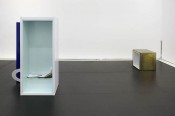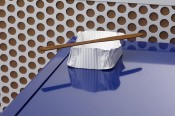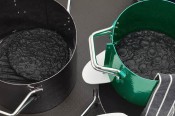Magali Reus’s exhibition “In Lukes and Dregs” came with a feverish press release promising “dirty realism,” “perversion,” “social taboo,” “filthy interiors,” “amoral vices,” “sexualized … protrusions,” Brutalism and fetishism – but visitors hoping for a McCarthyesque, abject grime-fest would have been badly let down. This was a coolly installed show combining eight squeaky-clean sculptures in a quietly thoughtful way. No smells, slime, or grisly prostheses; rather, a calm reflection on ideas of material preservation and indeterminacy – and by extension (since all that stuff that doesn’t die is both “of us” and “not us,” in complex ways) on present-day puzzles over human relationships to inanimate matter.
The clues were everywhere – in the show’s imagery, most obviously. The three pieces from a series bearing the curious title “Lukes,” 2013–*, resemble simplified fridges, while those from the “Dregs” series, 2013 –, look like cooking pots – preserving pans, maybe? Meanwhile, in a handout, deliberately lengthy lists of materials bore evidence of obsessive and very twenty-first-century methods of laser-cutting, sealing, protecting, and finessing substances and surfaces. Aluminum had been hand-hammered, sandblasted, mirror-polished, or powder-coated, and zinc sheet “coated with passivate” (to reduce its environmental reactivity, as well as to give it the distinctive brassy-yellow iridescence of the metal substructures you find inside electrical appliances). Inside the “fridges” are pieces of foil that have been powder-coated, giving them an incongruous sense of rigidity and permanence, and knife-shaped steel items whose evenly rusted surfaces recall rust’s preservative rather than its destructive connotations. Also in the mix: “protective” plastics and netting, and “snake-eye security nuts and bolts” – all the better to keep things fixed exactly in place, my dear.
In fact, Reus’s array of pans and fridges did include some real scraps of food, but nothing you could eat, no matter how famished you might have been: each last bit had been embedded in another deodorizing, preservative substance. Lukes (Aggregate Local), 2014, is a small fridge tipped on its back. Inside, held in a block of transparent, lavender-tinted polyester, cabbage leaves swim like tiny ornamental carp. In Dregs (Pyramid Simmer) and Dregs (Flash Batch), both 2013, “pans” assembled from flat metal sheeting (and thus entirely unfit for cooking purposes) contain, wonderfully, “rubber dipped burnt pizzas.”
If, viewed one way, Reus’s installation was a not-quite-kitchen, it was at least equipped with some not-quite-plumbing. Creeping around its periphery was Filer, 2014, four sections of partially routed-out aluminum tubing filled with foil, food packaging, plastic mesh, and the like. Tucked alongside the not-quite knives, fridges, pans, and so on were also a few not-quite toilet seats. And in a clever twist, the installation’s floor had also been given neither-nor status: It had been raised by just a few inches and set in from the walls, creating a border, or gutter, around its perimeter. Thus, it served as both floor and sculptural plinth.
Reus’s contradictory collision of material preservation and material indeterminacy was deftly executed. Robert Gober’s 1990s installations would be a good point of comparison, not least to highlight the changed terrains of present-day sculpture. Parked on young sculptors’ bedside tables right now, one guesses, are not texts by Freud or Kristeva but fluorescent-highlighted photocopies of texts teasing out questions of anthrodecentrism, speculative realism, and object-oriented ontology in its various guises. Also shadowing Reus’s games with materials is today’s fascinating universe of consumer products made from alien-seeming, new-fangled, high-performance stuff: super-absorbent hydrophilic polymers, silicones that turn fuzzy heads of hair to spun silk, indestructible-seeming plastics, or that ultimate counterintuitive substance, the two-dimensional object graphene. It is within, and against, this remarkable new realm of materials that Reus and her peers (Alice Channer, for instance) are plotting their ideas.
*The title “Lukes” proved surprisingly resistant to etymological research. A provisional definition was supplied by retired architect Margaret Withers: the noun is related to “lees” or “lyes” and is roughly synonymous with dregs or residue. So, appropriately enough, it appears itself to be a type of linguistic left-over.
Magali Reus: In Lukes and Dregs showed at The Approach between 18 January and 16 February 2014
Text © Rachel Withers & Artforum International Magazine, Inc. 2014.
Images © Magali Reus and The Approach.


